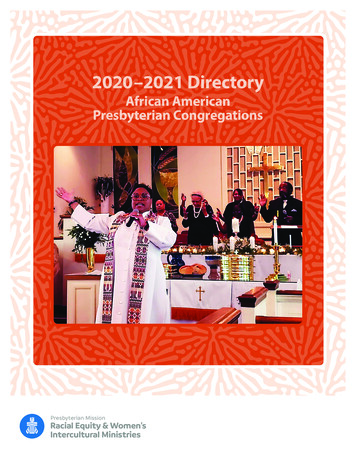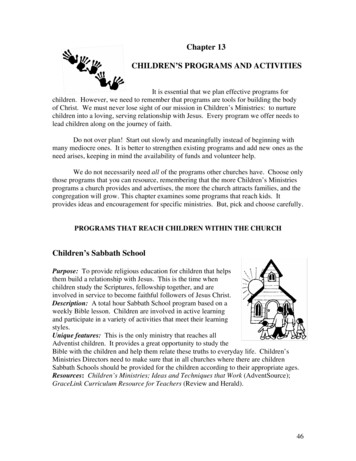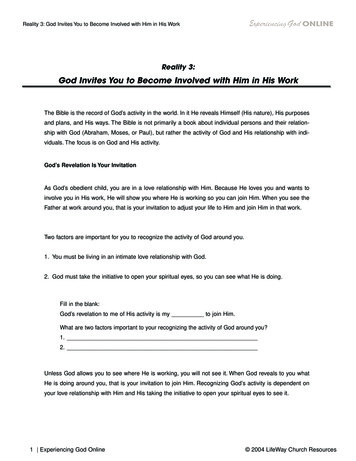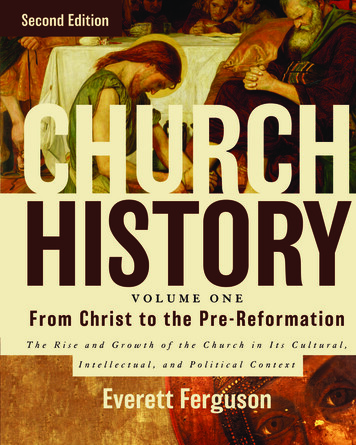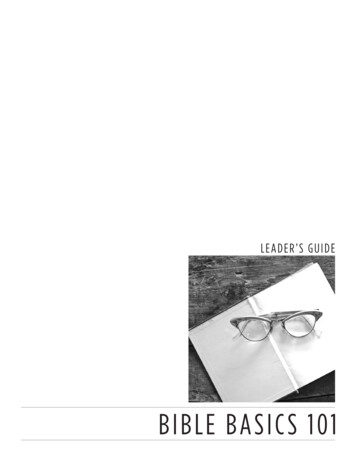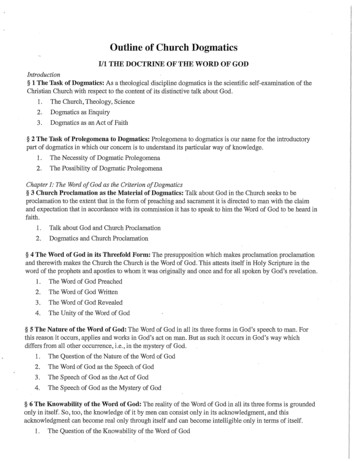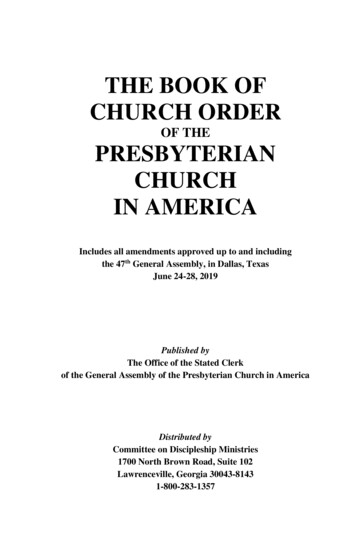
Transcription
THE BOOK OFCHURCH ORDEROF THEPRESBYTERIANCHURCHIN AMERICAIncludes all amendments approved up to and includingthe 47th General Assembly, in Dallas, TexasJune 24-28, 2019Published byThe Office of the Stated Clerkof the General Assembly of the Presbyterian Church in AmericaDistributed byCommittee on Discipleship Ministries1700 North Brown Road, Suite 102Lawrenceville, Georgia 30043-81431-800-283-1357
PUBLISHER'S INTRODUCTIONAmendments finally adopted by the General Assembly in the current year areindicated in The Book of Church Order (BCO) by a bullet in the margin besidethe line where the change was made. New wording is underlined. Insubsequent BCO reprints, marginal bullets and underlining for previous yearsare deleted. See the following page for a listing of changes in the BCO, theRules of Assembly Operations (RAO), the Operating Manual for the StandingJudicial Commission (OMSJC), and the Corporate Bylaws.The Stated Clerk will appreciate receiving notice of any needed corrections tothis 2019 update of the BCO.Editorial Note:For a chronological history of changes to the BCO, RAO, and OMSJC from 1982 tothe present, see the list following the title page of the BCO. For a topical (chapter bychapter) listing of BCO changes, go to http://www.pcahistory.org/bco/.This publication is intended for the work and mission of the Church. It may not berepublished in any form or by any means without the prior written permission of thepublisher. Publication of any commentary or other reference work must include writtenpermission for use of text from this document.Copyright 2019 by the Office of the Stated Clerkof the General Assembly of the Presbyterian Church in AmericaAll rights reserved
NOTE: The following amendments to The Book of Church Order (BCO), Rules of AssemblyOperations (RAO), Operating Manual of the Standing Judicial Commission (OMSJC), andCorporate Bylaws were adopted by the General Assembly in:1982 – 8-7; 13-5; 14-1-12; 21-4; 23-2; 26-4; Index1983 – 8-4; 10-3; 13-2; 23-1; Index1984 – Chapter 5; 13-2; 14-1-12; 24-9; Chapter 42; Chapter 43; Index1985 – 5-9; 13-2; New 15-4; 20-1; 23-1; Index1986 – Pref. II, 1; 8-3; 12-5; 13-10; New 14-7; 18-2; 19-7; 19-8; 19-11; 19-16; 20-12; 20-13; 21-4;24-1; 38-2; Index1987 – 42-4; 43-2; 3; Chapter 45; Index1988 – Pref. III; 8-3; 12-5; 13-8; 13-10; 14-3; 19-6; 19-10; 20-5; 20-9; 21-4; 22-3; 22-4; 24-6; 25-2;26-1; 28-4; 32-2; 35-5; Index1989 – Pref. II, 1; III; 13-6; 14-1-12; 18-2; 19-2,b, 2; 19-5; 21-1; 21-4; 23-2; 23-3; 26-1; 30-1; 30-3;31-1; 33-1; 34-1; 34-8; 34-9; 56-4; (also 15-1; 15-3; 15-4; 15-5 – adopted in 1988)1990 – BCO 14-1.14; 19-10; 30-1,3; 34-7,8; 36-4,5; 37-1,2,3,7,8; 42-6; 45-1,4,5; 46-51991 – BCO 14-1.11; 14-1.12; 14-2; 15-21992 – BCO 10-3; 42-11; 43-3; 43-71993 – BCO 14-1.15; 15-4; 24-51994 – BCO 15-1; 21-4.d; 24-1; 37-9; RAO 4-3; 4-6; 5-1; 13-1; 13-6; 13-13.c.6; 13-14.d; 14-9.c;Corporate Bylaws Article VI, p. R-39 and Certificate of Incorporation, pp. R-29-311995 – BCO 13-10; 14-1.12; 32-18; RAO 15-3 and Corporate Bylaws Article IV,4 and VII,11996 – BCO 35-14; 42-5; 42-6; RAO 14 and Corporate Bylaws Article VI,51997 – BCO Preface II, 15-1, 15-4, 15-5, 19-1, 19-6, 38-4, 39-3, 46-2, 46-51998 – BCO 13-6; 15-5c; 38-3; RAO 14-7; Corporate Bylaws Article VI,51999 – BCO 13-5; 13-12; 20-2; 32-6; 33-2; 33-3; 34-4; RAO 4-18 [editorial changes to 15-3 and16-3]; SJC Manual 6.2d; 8.3b; 19.10c; and 19.11 [editorial changes to 11.9a.2 and 18.7b]2000 – BCO 13-12; 15-1; 24-1; 38-1; 43-52001 – BCO 14-1.12; Appendix B; Appendix H; RAO 4-5, 9-6, 15-2; Corporate Bylaws ArticleVI,1; VI,4; VI,52002 – BCO 12-5.e, 13-1, 14-1.12, 32-3, 32-4, 32-18, 35-7, 43-1, Appendix I; RAO 4-2, 4-3, 4-8, 49, 5-1, 6-4, 7-5.c, 13-1; SJC Manual 13.8.c.5, 6, 16, 18, 19-22 renumbered; CorporateBylaws Article V,E; V,F; V,G; Article VI,1; VI,52003 – BCO 14-1.12b.4, 21-4, 21-5.6; RAO 13-1.6, 13-2, 13-5d, 13-6.e, 13-6.f-j renumbered; 143.e.5, 14-8; SJC Manual 13.10, 14.7, 15.7, 19.8.j, 19.8.k, 20.12, 21.2.f; Corporate BylawsArticle VI,12004 – BCO 58-5; SJC Manual 3.1, 11.7b, 12.3.b2005 – BCO 24-3; 24-5; 24-6-9 relettered; 24-9 (now 24-10)2006 – BCO 15-4; 24-1.b; 40-5; RAO 2006 revised edition2007 – RAO 4-11; 11-1; 14-8.d; 19-2; SJC Manual 21-3
2008 – BCO 2-1, 12-2; RAO 14-6.k; 14-9.e, g; 14-9.f relettered; 15-8.c, e; 15-8.f-g relettered.[Editorial note added RAO 14-6.d and 15-6.i; editorial changes SJC 10.5; 11.6; 16.2;17.2.(d); 18.1.(a); 21.5; 22.1]]2009 – 21-4 (editorial numeration); 59-1, 6; RAO 14-9.h (3); 15-8.g (3); 19-4.d; SJC Manual 3.2;8.4 (a), (b); 11.10; 11.11; 13.10; 14.7; 15.7; 16; 19.6; 19.7 (a), (c); 20.62010 – No BCO changes; no RAO changes; SJC Manual new Section 2 added with renumbering thereafter; 3.1; Sections 6 & 7 deleted; Section 17 moved to replace original 11:8; 13.8; 14.2;15.2; 19.52011 – BCO 5-2; 5-3; 5-4; 5-8; 5-9; 5-10; 5-11; add new 5-5 & renumber as needed; 9-7; 13-6;15-2; 37-7; RAO 16-3.e.5; SJC Manual 10.7.a; 12.10; 13.7; 14.7; 17.8.k; 18.2.2012 – BCO 19-11; RAO 5-4; 8-3; 10-8; 11-5; 12-1; 14-6.h; 15-1; OMSJC 8.1.a, b; 8.4; 18:12;18:132013 – BCO 19-2; 20-3; 24-2; 25-4; 42-4; 43-2; 43-3; Appendix J added; RAO 8-5.b; 10-9added; 16-10.a; OMSJC 3.7; 9.1; 10.72014 – BCO 34-8; 37-6; 43-10; [editorial corrections: BCO 13-6; 39-3]; RAO 16-3.e.6;16-3.e.7, 8 (renumbered); 16-6.c.1; [editorial corrections: RAO 11-5; 11-8]; [OMSJCeditorial corrections: 18.11; 18.12.b.(4)]; References to Committee on ChristianEducation and Publications (CEP) changed to Committee on Discipleship Ministries(CDM) – BCO 14-1.12; RAO 4-2; 5-1.b.1); 6-1; 14-1.22015 – BCO 5-2; 8-6; 18-7; 43-3, 8, 9; RAO 14-6.a; 14-6.e; OMSJC 4.l; 7.4; 9.2.e; 10.3.d; 10.62016 – [editorial correction: BCO 58-5]; RAO 8-4.i; OMSJC 7.2.b; 7.4.d; 7.4 (add 7.4.b. and reletter); 10.9; 18.12.b, c2017 – BCO 5-3; 13-2; editorial – BCO 55-1; RAO 7-3.c; 9-2 (added and renumbering); 13-2; 136 (added); 14-8; 17-4; OMSJC 8.2; 8.4.a; 10.11.a (6) and (7); 17.5; 17.7; ReformedUniversity Ministries (RUM) name changed to Reformed University Fellowship (RUF):BCO 14-1.12; RAO 4-2, 5-1, 6-4, 14-1.10; Bylaws Article V.2018 – BCO [editorial additions/corrections: 42-6, parenthetical reference; Appendices, introductorynote; Appendix C, Scripture references; Appendix I, preface]; RAO 8-4.i; 13-2; 16-7.h; 16-10.c;formatting corrections: 6-1; 14-7.c; OMSJC 4.1; 10.11.a(2); 12.10; 13.7; 14.7; 15.9; 17.8.k;18.10.b; 18.12.c; 19.2.f2019 – BCO 8-1; 8-3; 25-11; 35-11; Preface to Directory for Worship; 59-3; RAO 11-5; 11-12; 13-2;13-6 (struck); 16-4.a; 16-4.c.1; 16-4. d.May the Lord, the King and Head of the Church, bless and honor these efforts to make clearerour form of governance.L. Roy TaylorStated Clerk of General Assembly
CONTENTSPREFACEI.II.III.The King and Head of the ChurchPreliminary PrinciplesThe Constitution DefinedPART I -- FORM OF GOVERNMENTCHAPTER 1The Doctrine of Church GovernmentCHAPTER 2The Visible Church DefinedCHAPTER 3The Nature and Extent of Church PowerCHAPTER 4The Particular ChurchCHAPTER 5The Organization of a Particular ChurchCHAPTER 6Church MembersCHAPTER 7Church Officers - General ClassificationCHAPTER 8The ElderCHAPTER 9The DeaconCHAPTER 10Church Courts in GeneralCHAPTER 11Jurisdiction of Church CourtsCHAPTER 12The Church SessionCHAPTER 13The PresbyteryCHAPTER 14The General AssemblyCHAPTER 15Ecclesiastical CommissionsCHAPTER 16Church Orders - The Doctrine of VocationCHAPTER 17Doctrine of OrdinationCHAPTER 18Candidates for the Gospel Ministry
CHAPTER 19The Licensure of Candidates for theGospel Ministry and InternshipCHAPTER 20The Election of PastorsCHAPTER 21The Ordination and Installation of MinistersCHAPTER 22The Pastoral RelationsCHAPTER 23The Dissolution of the Pastoral RelationCHAPTER 24Election, Ordination and Installation ofRuling Elders and DeaconsCHAPTER 25Congregational MeetingsCHAPTER 26Amending the Constitution of the ChurchPART II -- THE RULES OF DISCIPLINECHAPTER 27Discipline - Its Nature, Subjects and EndsCHAPTER 28Discipline of Non-communing MembersCHAPTER 29OffensesCHAPTER 30Church CensuresCHAPTER 31The Parties in Cases of ProcessCHAPTER 32General Provisions Applicable to all Cases of ProcessCHAPTER 33Special Rules Pertaining to Process Before SessionsCHAPTER 34Special Rules Pertaining to Process Against a Minister(Teaching Elder)CHAPTER 35EvidenceCHAPTER 36The Infliction of Church CensuresCHAPTER 37The Removal of CensureCHAPTER 38Cases Without ProcessCHAPTER 39Modes in Which the Proceedings of Lower CourtsCome Under the Supervision of Higher Courts
CHAPTER 40General Review and ControlCHAPTER 41ReferencesCHAPTER 42AppealsCHAPTER 43ComplaintsCHAPTER 44VacatedCHAPTER 45Dissents, Protests and ObjectionsCHAPTER 46JurisdictionPART III -- THE DIRECTORY FOR THE WORSHIP OF GODCHAPTER 47The Principles and Elements of Public WorshipCHAPTER 48The Sanctification of the Lord's DayCHAPTER 49The Ordering of Public WorshipCHAPTER 50The Public Reading of the Holy ScriptureCHAPTER 51The Singing of Psalms and HymnsCHAPTER 52Public PrayerCHAPTER 53The Preaching of the WordCHAPTER 54The Worship of God by OfferingsCHAPTER 55Confessing the FaithCHAPTER 56The Administration of Baptism(The Baptism of Infants and Children)CHAPTER 57The Admission of Persons to Sealing OrdinancesCHAPTER 58The Administration of the Lord's SupperCHAPTER 59The Solemnization of MarriageCHAPTER 60The Visitation of the SickCHAPTER 61The Burial of the Dead
CHAPTER 62Days of Fasting and ThanksgivingCHAPTER 63Christian Life in the HomeOPTIONAL FORMS FOR PARTICULAR SITUATIONS[NOTE: The following documents are for information.They are not part of the Constitution of the PCA.]Appendix AMarriage ServiceAppendix BA Second Marriage ServiceAppendix CA Funeral ServiceAppendix DA Child's FuneralAppendix EService at the GraveAppendix FThe Dedication of a Church BuildingAppendix GI.II.III.IV.V.VI.Suggested Forms for Use in DisciplineCharge and SpecificationsCitation of AccusedCitation of WitnessNotice of Intention to AppealAppealComplaintAppendix HSuggested Procedures for Presbytery JudicialCommissions Acting as Appellate CourtsAppendix IBiblical Conflict ResolutionAppendix JSample Form for Terms of CallINDEX TO BCORULES OF ASSEMBLY OPERATIONSSTANDING JUDICIAL COMMISSION MANUALCERTIFICATE OF INCORPORATIONCORPORATE BYLAWSNAPARC AGREEMENTS
PREFACE TOTHE BOOK OF CHURCH ORDERI. THE KING AND HEAD OF THE CHURCHJesus Christ, upon whose shoulders the government rests, whose nameis called Wonderful, Counselor, the Mighty God, the Everlasting Father, thePrince of Peace; of the increase of whose government and peace there shall beno end; who sits upon the throne of David, and upon His kingdom to order itand to establish it with judgment and justice from henceforth, even forever(Isaiah 9:6-7); having all power given unto Him in heaven and in earth by theFather, who raised Him from the dead and set Him at His own right hand, farabove all principality and power, and might, and dominion, and every namethat is named, not only in this world, but also in that which is to come, and hasput all things under His feet, and gave Him to be the Head over all things tothe Church, which is His body, the fullness of Him that filleth all in all(Ephesians 1:20-23); He, being ascended up far above all heavens, that Hemight fill all things, received gifts for His Church, and gave all officesnecessary for the edification of His Church and the perfecting of His saints(Ephesians 4:10-13).Jesus, the Mediator, the sole Priest, Prophet, King, Saviour, and Headof the Church, contains in Himself, by way of eminency, all the offices in HisChurch, and has many of their names attributed to Him in the Scriptures. Heis Apostle, Teacher, Pastor, Minister, Bishop and the only Lawgiver in Zion.It belongs to His Majesty from His throne of glory to rule and teachthe Church through His Word and Spirit by the ministry of men; thus mediatelyexercising His own authority and enforcing His own laws, unto the edificationand establishment of His Kingdom.Christ, as King, has given to His Church officers, oracles andordinances; and especially has He ordained therein His system of doctrine,government, discipline and worship, all of which are either expressly set downin Scripture, or by good and necessary inference may be deduced therefrom;and to which things He commands that nothing be added, and that from themnaught be taken away.Since the ascension of Jesus Christ to heaven, He is present with theChurch by His Word and Spirit, and the benefits of all His offices areeffectually applied by the Holy Ghost.
THE BOOK OF CHURCH ORDERII. PRELIMINARY PRINCIPLESThe Presbyterian Church in America, in setting forth the form ofgovernment founded upon and agreeable to the Word of God, reiterates thefollowing great principles which have governed the formation of the plan:1. God alone is Lord of the conscience and has left it free from anydoctrines or commandments of men (a) which are in any respectcontrary to the Word of God, or (b) which, in regard to matters offaith and worship, are not governed by the Word of God. Therefore,the rights of private judgment in all matters that respect religion areuniversal and inalienable. No religious constitution should besupported by the civil power further than may be necessary forprotection and security equal and common to all others.2. In perfect consistency with the above principle, every ChristianChurch, or union or association of particular churches, is entitled todeclare the terms of admission into its communion and thequalifications of its ministers and members, as well as the wholesystem of its internal government which Christ has appointed. Inthe exercise of this right it may, notwithstanding, err in making theterms of communion either too lax or too narrow; yet even in thiscase, it does not infringe upon the liberty or the rights of others, butonly makes an improper use of its own.3. Our blessed Saviour, for the edification of the visible Church,which is His body, has appointed officers not only to preach theGospel and administer the Sacraments, but also to exercisediscipline for the preservation both of truth and duty. It isincumbent upon these officers and upon the whole Church in whosename they act, to censure or cast out the erroneous and scandalous,observing in all cases the rules contained in the Word of God.4. Godliness is founded on truth. A test of truth is its power topromote holiness according to our Saviour's rule, "By their fruits yeshall know them" (Matthew 7:20). No opinion can be morepernicious or more absurd than that which brings truth andfalsehood upon the same level.On the contrary, there is an inseparable connection betweenfaith and practice, truth and duty. Otherwise it would be of noconsequence either to discover truth or to embrace it.
PREFACE5.6.7.8.While, under the conviction of the above principle, it is necessaryto make effective provision that all who are admitted as teachers besound in the faith, there are truths and forms with respect to whichmen of good character and principles may differ. In all these it isthe duty both of private Christians and societies to exercise mutualforbearance toward each other.Though the character, qualifications and authority of churchofficers are laid down in the Holy Scriptures, as well as the propermethod of officer investiture, the power to elect persons to theexercise of authority in any particular society resides in that society.All church power, whether exercised by the body in general, or byrepresentation, is only ministerial and declarative since the HolyScriptures are the only rule of faith and practice. No churchjudicatory may make laws to bind the conscience. All church courtsmay err through human frailty, yet it rests upon them to uphold thelaws of Scripture though this obligation be lodged with falliblemen.Since ecclesiastical discipline must be purely moral or spiritual inits object, and not attended with any civil effects, it can derive noforce whatever, but from its own justice, the approbation of animpartial public, and the countenance and blessing of the greatHead of the Church.If the preceding scriptural principles be steadfastly adhered to, thevigor and strictness of government and discipline, applied with pastoralprudence and Christian love, will contribute to the glory and well-beingof the Church.III. THE CONSTITUTION DEFINEDThe Constitution of the Presbyterian Church in America, which issubject to and subordinate to the Scriptures of the Old and New Testaments,the inerrant Word Of God, consists of its doctrinal standards set forth in theWestminster Confession of Faith, together with the Larger and ShorterCatechisms, and the Book of Church Order, comprising the Form ofGovernment, the Rules of Discipline and the Directory for Worship; all asadopted by the Church.
This page intentionally left blank.
PART IFORM OF GOVERNMENTCHAPTER 1The Doctrine of Church Government.1-1.The scriptural form of church government, which is representative orpresbyterian, is comprehended under five heads: a. The Church; b. Itsmembers; c. Its officers; d. Its courts; e. Its orders.1-2.The Church which the Lord Jesus Christ has erected in this world forthe gathering and perfecting of the saints is His visible kingdom of grace, andis one and the same in all ages.1-3.The members of this visible Church catholic are all those persons inevery nation, together with their children, who make profession of their faithin the Lord Jesus Christ and promise submission to His laws.1-4.The officers of the Church, by whom all its powers are administered,are, according to the Scriptures, teaching and ruling elders and deacons.1-5.Ecclesiastical jurisdiction is not a several, but a joint power, to beexercised by presbyters in courts. These courts may have jurisdiction over oneor many churches, but they sustain such mutual relations as to realize the ideaof the unity of the Church.1-6.The ordination of officers is ordinarily by a court, except in the caseof ordination by a presbytery's evangelist (see BCO 8-6).1-7.This scriptural doctrine of Presbytery is necessary to the perfection ofthe order of the visible Church, but is not essential to its existence.
This page intentionally left blank.
FORM OF GOVERNMENT2-1CHAPTER 2The Visible Church Defined2-1.The Visible Church before the law, under the law, and now under theGospel, is one and the same and consists of all those who make profession oftheir faith in the Lord Jesus Christ, together with their children.2-2.This visible unity of the body of Christ, though obscured, is notdestroyed by its division into different denominations of professing Christians;but all of these which maintain the Word and Sacraments in their fundamentalintegrity are to be recognized as true branches of the Church of Jesus Christ.2-3.It is according to scriptural example that the Church should be dividedinto many individual churches.
This page intentionally left blank.
FORM OF GOVERNMENT3-1CHAPTER 3The Nature and Extent of Church Power3-1.The power which Christ has committed to His Church vests in thewhole body, the rulers and those ruled, constituting it a spiritualcommonwealth. This power, as exercised by the people, extends to the choiceof those officers whom He has appointed in His Church.3-2.Ecclesiastical power, which is wholly spiritual, is twofold. Theofficers exercise it sometimes severally, as in preaching the Gospel,administering the Sacraments, reproving the erring, visiting the sick, andcomforting the afflicted, which is the power of order; and they exercise itsometimes jointly in Church courts, after the form of judgment, which is thepower of jurisdiction.3-3.The sole functions of the Church, as a kingdom and governmentdistinct from the civil commonwealth, are to proclaim, to administer, and toenforce the law of Christ revealed in the Scriptures.3-4.The power of the Church is exclusively spiritual; that of the Stateincludes the exercise of force. The constitution of the Church derives fromdivine revelation; the constitution of the State must be determined by humanreason and the course of providential events. The Church has no right toconstruct or modify a government for the State, and the State has no right toframe a creed or polity for the Church. They are as planets moving inconcentric orbits: "Render unto Caesar the things that are Caesar's and to Godthe things that are God's" (Matthew 22:21).3-5.The Church, with its ordinances, officers and courts, is the agencywhich Christ has ordained for the edification and government of His people,for the propagation of the faith, and for the evangelization of the world.3-6.The exercise of ecclesiastical power, whether joint or several, has thedivine sanction when in conformity with the statutes enacted by Christ, theLawgiver, and when put forth by courts or by officers appointed thereunto inHis Word.
This page intentionally left blank.
FORM OF GOVERNMENT4-1CHAPTER 4The Particular Church4-1.A particular church consists of a number of professing Christians, withtheir children, associated together for divine worship and godly living,agreeable to the Scriptures, and submitting to the lawful government ofChrist's kingdom.4-2.Its officers are its teaching and ruling elders and its deacons.4-3.Its jurisdiction, being a joint power, is lodged in the church Session,which consists of its pastor, pastors, its associate pastor(s) and its ruling elders.4-4.The ordinances established by Christ, the Head, in His Church areprayer; singing praises; reading, expounding and preaching the Word of God;administering the Sacraments of Baptism and the Lord's Supper; public solemnfasting and thanksgiving; catechizing; making offerings for the relief of thepoor and for other pious uses; and exercising discipline; the taking of solemnvows, and the ordination to sacred office.4-5.Churches without teaching elders ought not to forsake the assemblingof themselves together, but should be convened by the Session on the Lord'sDay, and at other suitable times, for prayer, praise, the presenting andexpounding of the Holy Scriptures, and exhortation, or the reading of a sermonof some approved minister. In like manner, Christians whose lot is cast indestitute regions ought to meet regularly for the worship of God.
This page intentionally left blank.
FORM OF GOVERNMENT5-1CHAPTER 5The Organization of a Particular ChurchA. Mission Churches5-1.A mission church may be properly described in the same manner asthe particular church is described in BCO 4-1. It is distinguished from aparticular church in that it has no permanent governing body, and thus must begoverned or supervised by others. However, its goal is to mature and beorganized as a particular church as soon as this can be done decently and ingood order.5-2.Ordinarily, mission churches are established by Presbyteries withintheir boundaries.a. Initiatives to which the Presbytery may respond in establishing amission church include, but are not limited to, the following:i. The Presbytery establishes a mission church at its own initiative.ii. The Presbytery responds to the initiative of a Session of aparticular church.iii. The Presbytery responds to the petition of an independentgathering of believers who have expressed their desire to becomea congregation by submitting to the Presbytery a written request.b. In the event an existing non-PCA church is interested in coming intothe PCA, the Presbytery shall work with the church leadership todetermine whether the church should come into the PCA as a missionchurch or seek Presbytery approval to be received under the provisionsof BCO 13-8.c. Should it become necessary, the Presbytery may dissolve the missionchurch. Church members enrolled should be cared for according tothe procedures of 13-10.d. If the mission church is located outside the bounds of a Presbytery, theresponsibility may be exercised through the General Assembly’sCommittee on Mission to North America or Committee on Mission tothe World, as the case may be, according to the Rules of AssemblyOperations. In such a case the powers of the Presbytery in thefollowing provisions shall be exercised by the General Assemblythrough its appropriate committee.5-3.The mission church, because of its transitional condition, requires atemporary system of government. Depending on the circumstances and at itsown discretion, Presbytery may provide for such government in one of severalways:
5-3THE BOOK OF CHURCH ORDERa. Appoint an evangelist as prescribed in with BCO 8-6.b. Cooperate with the Session of a particular church in arranging amother-daughter relationship with a mission church. The Session maythen serve as the temporary governing body of the mission church.c. Appoint a BCO 15-1 commission to serve as a temporary Session ofthe mission church. When a minister of the Presbytery has beenapproved to serve as pastor of the mission church, he shall be includedas a member of the commission and serve as its moderator.The temporary system of government shall record and submit its records toPresbytery for annual review in the same manner as Sessions of particularchurches.5-4.Pastoral ministry for the mission church may be provided:a. by a minister of the Presbytery called by Presbytery to serve as pastor,orb. by stated, student, or ruling elder supply (BCO 22-5, -6), orc. by a series of qualified preachers approved by the temporarygovernment (BCO 12-5.e).5-5.The temporary government shall receive members (BCO 12-5.a) intothe mission church according to the provisions of BCO 57 so far as they maybe applicable. As members of the mission church those received arecommuning or non-communing members of the Presbyterian Church inAmerica.a. If there is a minister approved by Presbytery to serve the missionchurch as its pastor (BCO 5-4.a), each member so received shall beunderstood to assent to the call of that minister and to affirm thepromises made to the pastor in BCO 21-10.b. Meetings of the members of the mission church shall be governedaccording to the provisions of BCO 25 so far as they may beapplicable.5-6.Mission churches and their members shall have the right of judicialprocess to the court having oversight of their temporary governing body.5-7.Mission churches shall maintain a roll of communicant and noncommunicant members, in the same manner as, but separate from, otherparticular churches.5-8.It is the intention of the Presbyterian Church in America that missionchurches enjoy the same status as particular churches in relation to civilgovernment.
FORM OF GOVERNMENT5-9B. The Organization of a Particular Church5-9.A new church can be organized only by the authority of Presbytery.a. A Presbytery should establish standing rules setting forth theprerequisites that qualify a mission church to begin the organizationprocess, e.g., the minimum number of petitioners and the level offinancial support to be provided by the congregation. The number ofofficers sufficient to constitute the quorum for a session shall benecessary to complete the organization process.b. The temporary government of the mission church shall oversee thesteps necessary for organization.c. When the temporary government determines that among the membersof the mission congregation there are men who appear qualified asofficers, the nomination process shall begin and the election concludefollowing the procedures of BCO 24 so far as they may be applicable.d. The election of officers shall normally take place at least two weeksprior to the date of the organization service. However, the effectivedate of service for the newly elected officers shall be upon thecompletion of the organization service.e. If deacons are not elected, the duties of the office shall devolve uponthe session, until deacons can be secured.f. If there is a minister approved by Presbytery to serve the missionchurch as its pastor, and members of the mission church have beenreceived according to BCO 5-5, the temporary session shall call acongregational meeting at which the congregation may, by majorityvote, call the organizing pastor to be their pastor without the steps ofBCO 20. If no such minister has been appointed, or the minister orcongregation choose not to continue the pastoral relationship of thenewly organized church, a pastor shall be called as follows:(1) The temporary government shall oversee the election of a pastoraccording the provisions of BCO 20 so far as they are applicable.If a candidate is to be proposed before the organization, thecongregational meeting to elect a pastor shall take place earlyenough for Presbytery to consider and approve the pastor’s callprior to the service of organization. This may be the same meetingcalled for the election of other officers.(2) The ordination and/or installation shall be according to theprovisions of BCO 21 so far as they are applicable. The servicemay take place at the service of organization.
5-9THE BOOK OF CHURCH ORDERg. In order to proceed to organization as a particular church the membersof the mission church shall sign a petition to Presbytery requesting thesame.h. Upon Presbytery’s approval of the petition, Presbytery shall appointan organizing commission and shall set the date and time of theorganization service.i. At the service of organization the following elements shall be includedin the order deemed by the organizing commission to be appropriate:(1) The organizing commission shall ordain and/or install rulingelders and/or deacons according to the provisions of BCO 24-6 sofar as they may be applicable.(2) If a pastor is being ordained and/or installed at the service, theorganizing commission shall act according to the provisions ofBCO 21 so far as they may be applicable.(3) A member of the organizing commission shall requirecommunicant members of the mission church present to enter intocovenant, by answering the following question affirmatively, withuplifted hand:Do you, in reliance on God for strength
THE BOOK OF CHURCH ORDER OF THE PRESBYTERIAN CHURCH IN AMERICA Includes all amendments approved up to and including the 47th General
